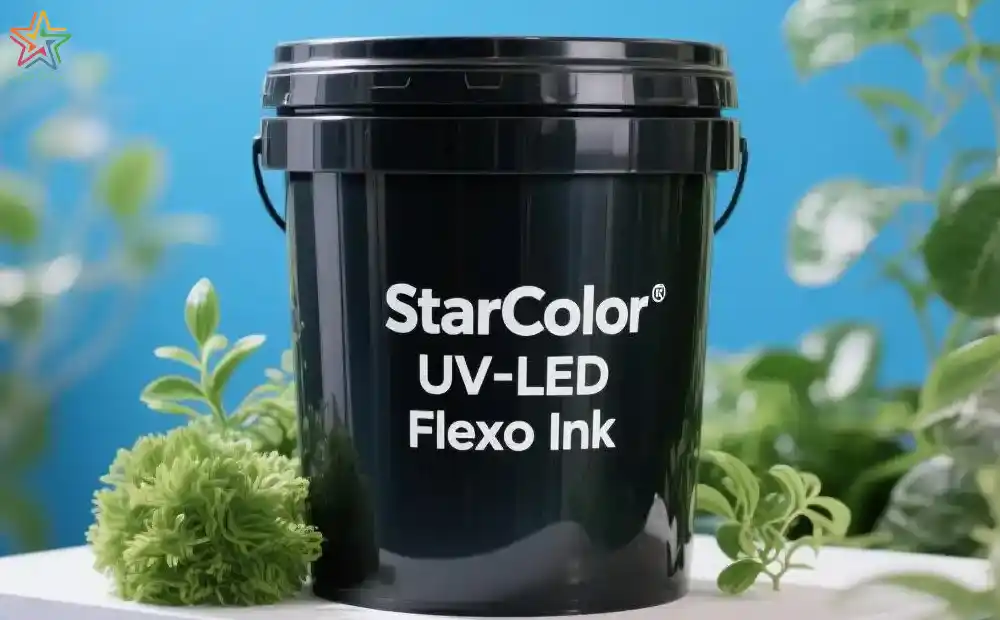How to Properly Store Flexographic UV Ink
Date: May 20 2025 From: Star Color Views:
I. Core Storage Parameter Matrix
The storage environment of UV inks directly impacts their chemical stability and printing performance. Below are key indicators with safety thresholds, over-limit risks, and monitoring tools:
| Indicator |
Safety Threshold |
Over-limit Risk |
Monitoring Tool |
| Temperature |
15–25°C |
>28°C → Accelerated prepolymerization reaction, causing ink to thicken or cure prematurely |
Electronic temperature recorder (±0.5°C accuracy) |
| Relative Humidity |
40–60%RH |
>70%RH → Moisture absorption leads to viscosity anomalies and affects printability |
Temperature-humidity sensor (cloud-synced data) |
| UV Intensity |
<5μW/cm² |
>20μW/cm² → Premature activation of photoinitiators, causing surface skinning and waste |
UV illuminometer (e.g., Testo 540) |
| Stacking Pressure |
<200kg/m² |
>300kg/m² → Barrel deformation and leakage risks |
Pressure-sensitive labels (visual alarm) |
Industry Standard: Comply with ISO 2846-1:2023
General Requirements for Storage of Printing Inks to ensure storage environments meet international specifications.

II. Light Protection and Anti-Polymerization Operation Specifications
1. Photosensitive Protection Solutions
Packaging Design:
- Use double-layer containers: inner layer of black HDPE (high-density polyethylene) to block visible light; outer layer of aluminum foil for light shielding, with UV blocking rate >99% (tested at 395nm wavelength).
- Sealing lids must pass UV blocking performance tests to ensure complete isolation of UV light during storage.
Warehouse Modification:
- Lighting system uses red light sources (wavelength >620nm, intensity <10lux) to avoid blue/UV light triggering premature ink reactions.
- Windows installed with UV blocking film, blocking >95% of wavelengths below 380nm to shield natural UV light.
2. Open-Lid Operation Rules
- Single material retrieval time controlled within 3 minutes to minimize ink-light exposure.
- After temporary opening, immediately cover with aluminum foil shading cloth (reflectivity >85%) to block residual light.
III. Precise Temperature and Humidity Control
1. Seasonal Management Strategies
Environmental challenges and solutions for different seasons:
| Season |
Challenge |
Solution |
Equipment Configuration |
| Summer |
High temperature (>30°C) |
Constant-temperature cold storage with ±2°C fluctuation control |
Dual-compressor industrial chillers for efficient cooling |
| Winter |
Low temperature (<10°C) |
Ink preheating room maintained at 25°C |
Infrared heating panels + intelligent temperature controllers for uniform heating |
| Mei Rain Season |
High humidity (>75%RH) |
Rotary dehumidifiers with dew point controlled at -40°C |
Humidity closed-loop control system for real-time adjustment |
2. Ink Rewarming Operations
- Refrigerated inks must follow a stepwise rewarming protocol: 5°C → 15°C → 25°C, with each stage lasting ≥4 hours to avoid component separation due to excessive temperature differences.
- Direct heating (e.g., open flames, heat guns) is strictly prohibited; temperature differences >10°C may cause ink delamination and affect print quality.
IV. Container Sealing and Stacking Standards
1. Sealing Grade Classification
Select appropriate sealing methods based on storage duration and ink characteristics:
| Sealing Method |
Oxygen Permeability (cc/m²·day) |
Application Scenario |
| Standard Screw Cap |
50–80 |
Short-term storage (<30 days), suitable for regular production batches |
| Nitrogen-Filled + Silicone Seal |
<5 |
Long-term storage (>6 months), ideal for inventory backup inks |
| Vacuum Aluminum Pouch |
0.1–0.5 |
Sensitive formulations (e.g., inks with TPO photoinitiators) requiring highest-level protection |
2. Three-Dimensional Warehousing Specifications
- Pallet stacking height ≤3 layers, total height <1.8 meters to prevent bottom container compression deformation.
- Storage area kept ≥50cm away from walls for air circulation and heat dissipation; passage width ≥1.2 meters to meet fire safety and handling requirements.
- Set up leak-proof containment barriers per OSHA standards, with capacity ≥110% of the largest single barrel volume to prevent safety hazards from accidental leaks.
V. Batch Management and First-In-First-Out (FIFO)
1. Information Management Process
Inbound Stage:
- Use barcode scanning to input production date, batch number, shelf life, etc., and synchronize initial viscosity and curing energy values (refer to QC test reports).
- Warehouse location allocation follows shelf life principles: Zone A for remaining shelf life >6 months, Zone B for 3–6 months, Zone C for <3 months, facilitating priority shipment.
Outbound Rules:
- System automatically triggers expiration warnings (red alert at 30 days remaining) to ensure FIFO compliance and reduce obsolete inventory losses.
2. Shelf Life Extension Techniques
- Add 0.1–0.3% polymerization inhibitors (e.g., p-hydroxyanisole) to suppress spontaneous photoinitiator reactions.
- Use nitrogen-filled storage (oxygen concentration <200ppm). BASF test data shows this method extends UV ink shelf life by 40%, effectively reducing inventory costs.
By implementing these full-process specifications, enterprises can systematically enhance
flexographic UV ink storage management, reduce ink failure caused by environmental factors from the source, achieve a 30% inventory loss reduction goal, and ensure printing production stability and product quality.
 RU
RU
 EN
EN
 CN
CN

